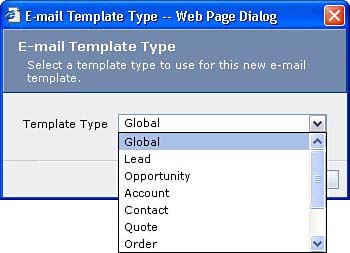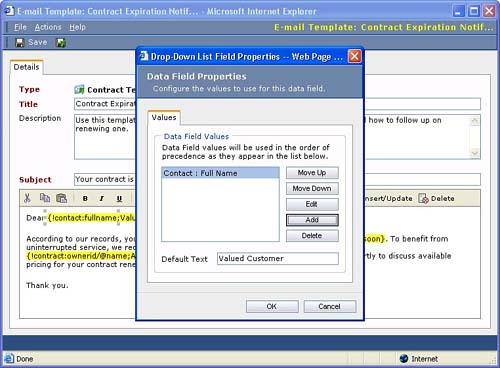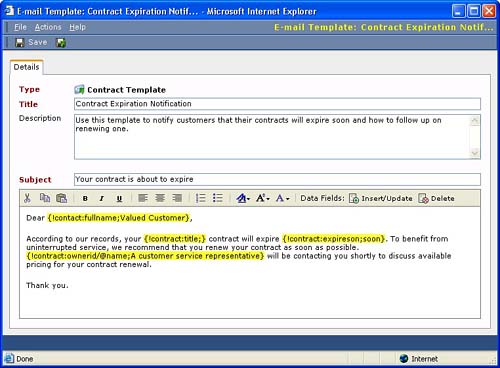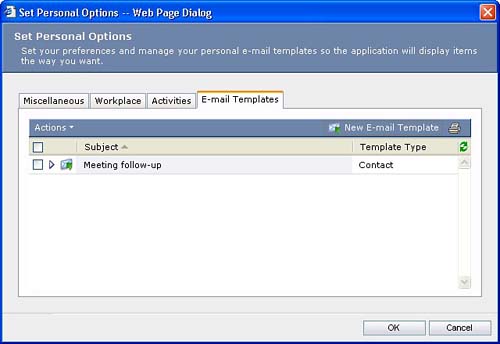Template Manager
The Template Manager is also accessible under the Settings tab. It enables you to set up the templates you will use for Service Contracts, Email and Knowledgebase articles. We'll go over Service Contracts and Knowledgebase articles in detail in Chapter 9, so for now let's dig into email templates. Email templates are preformatted emails that can be quickly sent to one or more recipients. Email templates have the ability to merge CRM data into the body of the email.
Setting up email templates is straightforward. When you select the New Email template button you will first be asked to select a type of template to create, as shown in Figure 5.25.
Figure 5.25. The types of email templates that can be created.

The types of templates along with the associated records from which data can be merged are listed in Table 5.3.
Note that in the case of Contact templates, the word "Contact" in the preceding table refers to the Contact itself and the word "Account" refers to the Contact's parent account. In all other cases, what the words "Account" and "Contact" refer to, depend on what the current object is linked to. "Account" may be the linked object (or the linked Contact's parent account) and "Contact" may be the linked object (or the linked Account's primary contact). For example, let's suppose we have an Opportunity template that displays the first name field on the Contact and suppose that we also have two opportunities. Opportunity A's potential customer is a Contact named Bob Jones and Opportunity B's potential Customer is ACME inc. When you highlight Opportunity A, click on "Send Direct Email," select the template, and Bob's name will be merged in the email. However, when you repeat the same operation with Opportunity B, the email will show ACME's primary contact's name.
This is excellent functionality. Imagine the scenario where you are a software company and you need to send out notices of software maintenance renewal based on the maintenance renewal date on the Service Contract. You could create a Contract email template to merge in the appropriate data points and turn this email generation into a short monthly task. Let's look at an example.
First, navigate to the Template Manager by clicking the Settings tab and selecting Template Manager. In Template Manager select Email Templates, and then select New Email Template. You will receive a dialog box asking you to select a template type. Select Contract and click the OK button. Now you will see the email template creation screen. Provide a title, description, and subject for your template, and then you can begin to compose the body of the email and insert merged fields. Select the Insert/Update button on the button bar of the email template and you will see the Data Field Properties dialog box, as shown in Figure 5.26.
Figure 5.26. Inserting a field into an email template.

Select the add button and you will be able to add a field to be merged. You can add several values, and then set their order of insertion using the Move Up and Move Down buttons. You can even use the “Default Text” field to include a substitute value that will be used if the merged field does not contain a value. When the email is created the system looks for a value for your highest-ranked choice first and, if a value does not exist, it will move on to the next highest ranked field. If a value cannot be found for a field you have selected and you have entered a value in the Default Text field, that default value will be merged into the email. Continue to add fields and text until the email is in the structure you desire. If you want to add a graphic to the email, open the graphic in a browser window, right-click the graphic and choose copy, and then paste the graphic into the email. With respect to adding autopopulated dates into an email, when Microsoft CRM adds date fields to emails, it inserts the date in the 2003-03-23T00:00:00-05:00 format. Although this does provide the requested information, it is not likely the date format one would prefer to read. Figure 5.27 depicts an email template for expiring Service Contracts.
Figure 5.27. An Email template for expiring Service Contracts.

In this example, I've set up an email template from the Template Manager section of the Settings tab. These templates can be thought of as System templates because they are created in Template Manager and made available to all users who have the right to create emails. Templates can also be created for use at the User level. These are referred to as Personal templates. Personal templates can be created by the user by going to the Tools menu and Selecting Options. The Email tab displays all existing personal templates and the New Email Template button enables the user to set up an email template. This is shown in Figure 5.28. From here the process is identical to that found in the Template Manager.
Figure 5.28. Creating personal email templates in the user options screen.

Besides sending email to groups of Leads, Contacts, and Accounts, email templates can be used for sending single emails directly from the individual Lead, Contact, or Account record. The Use Case Corner in this chapter provides a great example of how this functionality can be used. More on Microsoft CRM's email capability will be covered in the Marketing section of Chapter 7, “Sales Force Automation.”
